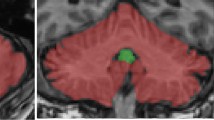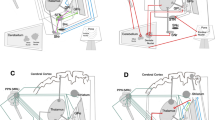Abstract
Bilateral symptoms and signs of Parkinson’s disease (PD) are often improved by unilateral subthalamic nucleus deep brain stimulation (STN-DBS). However, the mechanism for such bilateral effects is unknown. This study was intended to examine effects of unilateral STN-DBS using positron emission computed tomography (PET) and to elucidate mechanisms for bilateral improvement achieved by unilateral stimulation.
We conducted 18F-fluorodeoxyglucose (18FDG) and 18F-fluorodopa (18F-DOPA ) PET scans in PD patients whose bilateral limb symptoms and axial symptoms were improved by unilateral DBS. Two scans were performed in each PET study: when DBS was on and off. We compared those images using statistic parametric mapping (SPM) 99.
The significant clinical improvement obtained by unilateral DBS was shown as improvements in bilateral motor limb, axial, and gait subscores of the Unified PD Rating Scale (UPDRS). Moreover, 18FDG PET revealed significant metabolic increases in the ipsilateral ventrolateral thalamic areas and metabolic decrease at the contralateral globus pallidus interna (GPi). In contrast, 18F-DOPA PET showed no significant differences between DBS on and off.
Ipsilateral thalamic activation might induce ipsilateral motor cortical activation, which explains the improvement of contralateral limb symptoms. Furthermore, deactivation of the contralateral GPi might disinhibit the thalamus and contralateral motor cortex, which explains reduction of ipsilateral limb symptoms. These results suggest the mechanisms for bilateral improvement achieved by unilateral DBS.
Similar content being viewed by others
References
Bastian AJ, Kelly VE, Revilla FJ, Perlmutter JS, Mink JW (2003) Different effects of unilateral versus bilateral subthalamic nucleus stimulation on walking and reaching in Parkinson’s disease. Mov Disord 18:1000–1007
Bruet N, Windels F, Bertrand A, Feuerstein C, Poupard A, Savasta M (2001) High frequency stimulation of the subthalamic nucleus increases the extracellular contents of striatal dopamine in normal and partially dopaminergic denervated rats. J Neuropathol Exp Neurol 60:15–24
Chung SJ, Joen SR, Kim SR, Sung YH, Lee MC (2006) Bilateral effects of unilateral subthalamic nucleus deep brain stimulation in advanced Parkinson’s disease. Eur Neurol 56:127–132
DeLong MR (1990) Primate models of movement disorders of basal ganglia origin. Trends Neurosci 13:281–285
Dostrovsky JO, Lozano AM (2002) Mechanisms of deep brain stimulation. Mov Disord 17(Suppl 3):S63–S68
Germano IM, Gracies JM, Weisz DJ, Tse W, Koller WC, Olanow CW (2004) Unilateral stimulation of the subthalamic nucleus in Parkinson’s disease: a double- blind 12-month evaluation study. J Neurosurg 101:36–42
Hazrati LN, Parent A (1991) Contralateral pallidothalamic and pallidotegmental projections in primates: an anterograde and retrograde labeling study. Brain Res 567:212–223
Hershey T, Revilla FJ, Wernle AR, McGee-Minnich L, Antenor JV, Videen TO, Dowling JL, Mink JW, Perlmutter JS (2003) Cortical and subcortical blood flow effects of subthalamic nucleus stimulation. Neurology 61:816–821
Hilker R, Voges J, Ghaemi M, Lehrke R, Rudolf J, Koulousakis A, Herholz K, Wienhard K, Sturm V, Heiss WD (2003) Deep brain stimulation of the subthalamic nucleus does not increase the striatal dopamine concentration in parkinsonian humans. Mov Disord 18:41–48
Hilker R, Voges J, Weisenbach S, Kalbe E, Burghaus L, Ghaemi M, Lehrke R, Koulousakis A, Herholz K, Sturm V, Heiss WD (2004) Subthalamic nucleus stimulation restores glucose metabolism in associative and limbic cortices and in cerebellum: evidence from a FDG-PET study in advanced Parkinson’s disease. J Cereb Blood Flow Metab 24:7–16
Krack P, Batir A, Van Blercom N, Chabardes S, Fraix V, Ardouin C, Koudsie A, Limousin PD, Benazzouz A, LeBas JF, Benabid AL, Pollak P (2003) Five-year follow-up of bilateral stimulation of the subthalamic nucleus in advanced Parkinson’s disease. New Engl J Med 349:1925–1934
Kumar R, Lozano AM, Sime N, Halket E, Lang AE (1999) Comparative effects of unilateral and bilateral subthalamic nucleus deep brain stimulation. Neurology 53:561–566
Lavoie B, Parent A (1994) Pedunculopontine nucleus in the squirrel monkey: projections to the basal ganglia as revealed by anterograde tract-tracing methods. J Comp Neurol 344:210–231
Limousin P, Greene J, Pollak P, Rothwell J, Benabid AL, Frackowiak R (1997) Changes in cerebral activity pattern due to subthalamic nucleus or internal pallidum stimulation in Parkinson’s disease. Ann Neurol 42:283–291
Limousin P, Krack P, Pollak P, Benazzouz A, Ardouin C, Hoffmann D, Benabid AL (1998) Electrical stimulation of the subthalamic nucleus in advanced Parkinson’s disease. New Engl J Med 339:1105–1111
Linazasoro G, Van Blercom N, Lasa A (2003) Unilateral subthalamic deep brain stimulation in advanced Parkinson’s disease. Mov Disord 18:713–716
Liu X, Ford-Dunn HL, Hayward GN, Nandi D, Miall RC, Aziz TZ, Stein JF (2002) The oscillatory activity in the Parkinsonian subthalamic nucleus investigated using the macro-electrodes for deep brain stimulation. Clin Neurophysiol 113:1667–1672
McIntyre CC, Mori S, Sherman DL, Thakor NV, Vitek JL (2004) Electric field and stimulating influence generated by deep brain stimulation of the subthalamic nucleus. Clin Neurophysiol 115:589–595
Meissner W, Harnack D, Paul G, Reum T, Sohr R, Morgenstern R, Kupsch A (2002) Deep brain stimulation of subthalamic neurons increases striatal dopamine metabolism and induces contralateral circling in freely moving 6-hydroxydopamine-lesioned rats. Neurosci Lett 328:105–108
Otsuka M, Ichiya Y, Hosokawa S, Kuwabara Y, Tahara T, Fukumura T, Kato M, Masuda K, Goto I (1991) Striatal blood flow, glucose metabolism and 18F-dopa uptake: difference in Parkinson’s disease and atypical parkinsonism 54:898–904
Otsuka M, Ichiya Y, Kuwabara Y, Fukumura T, Sasaki M, Masuda K (1993) Evaluation of the ratio method compared with graphical analyses for estimating nigrostriatal function in human 18F-dopa PET studies with or without carbidopa. Nucl Med Commun 14:862–867
Payoux P, Remy P, Damier P, Miloudi M, Loubinoux I, Pidoux B, Gaura V, Rascol O, Samson Y, Agid Y (2004) Subthalamic nucleus stimulation reduces abnormal motor cortical overactivity in Parkinson’s disease. Arch Neurol 61:1307–1313
Parent A, Hazrati LN (1995) Functional anatomy of the basal ganglia. I. The cortico-basal ganglia-thalamo-cortical loop. Brain Res Brain Res Rev 20:91–127
Schroeder U, Kuehler A, Haslinger B, Erhard P, Fogel W, Tronnier VM, Lange KW, Boecker H, Ceballos-Baumann AO (2002) Subthalamic nucleus stimulation affects striato-anterior cingulate cortex circuit in a response conflict task: a PET study. Brain 125:1995–2004
Schroeder U, Kuehler A, Lange KW, Haslinger B, Tronnier VM, Krause M, Pfister R, Boecker H, Ceballos-Baumann AO (2003) Subthalamic nucleus stimulation affects a frontotemporal network: a PET study. Ann Neurol 54:445–450
Sestini S, Scotto di Luzio A, Ammannati F, De Cristofaro MT, Passeri A, Martini S, Pupi A (2002) Changes in regional blood flow caused by deepbrain stimulation of the subthalamic nucleus in Parkinson’s disease. J Nucl Med 43:725–732
Shi LH, Luo F, Woodward DJ, Chang JY (2006) Basal ganglia neural responses during behaviorally effective deep brain stimulation of the subthalamic nucleus in rats performing a treadmill locomotion test. Synapse 59:445–457
Stolze H, Klebe S, Poepping M, Lorenz D, Herzog J, Hamel W, Schrader B, Raethjen J, Wenzelburger R, Mehdorn HM, Deuschl G, Krack P (2001) Effects of bilateral subthalamic nucleus stimulation on parkinsonian gait. Neurology 57:144–146
Strafella AP, Dagher A, Sadikot AF (2003) Cerebral blood flow changes induced by subthalamic stimulation in Parkinson’s disease. Neurology 60:1039–1042
Strafella AP, Sadikot AF, Dagher A (2003) Subthalamic deep brain stimulation does not induce striatal dopamine release in Parkinson’s disease. Neuroreport 14:1287–1289
Tai YF, Piccini P (2004) Applications of positron emission tomography (PET) in neurology. J Neurol Neurosurg Psychiatry 75:669–676
Talairach J, Tournoux P (1988) Coplanar stereotaxic atlas of the human brain. New York, Thieme
The Deep Brain Stimulation for Parkinson’s Disease Study Group (2001) Deep-brain stimulation of the subthalamic nucleus or the pars interna of the globus pallidus in Parkinson’s disease. New Engl J Med 345:956–963
Thobois S, Fraix V, Savasta M, Costes N, Pollak P, Mertens P, Koudsie A, Le Bars D, Benabid AL, Broussolle E (2003) Chronic subthalamic nucleus stimulation and striatal D2 dopamine receptors in Parkinson’s disease: A (11)C-raclopride PET study. J Neurol 250:1219–1223
Vitek JL (2002) Mechanisms of deep brain stimulation: excitation or inhibition. Mov Disord 17(Suppl 3):S69–S72
Author information
Authors and Affiliations
Corresponding author
Rights and permissions
About this article
Cite this article
Arai, N., Yokochi, F., Ohnishi, T. et al. Mechanisms of unilateral STN-DBS in patients with Parkinson’s disease. J Neurol 255, 1236–1243 (2008). https://doi.org/10.1007/s00415-008-0906-7
Received:
Revised:
Accepted:
Published:
Issue Date:
DOI: https://doi.org/10.1007/s00415-008-0906-7




